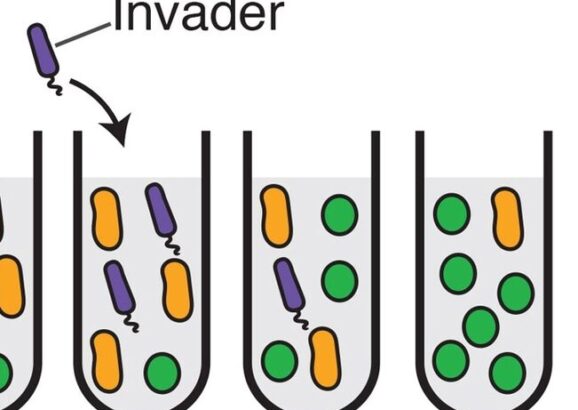Jeff Gore '99
Research Interests
The Gore biophysics laboratory uses microbial populations to explore how interactions within a population or community can lead to rich emergent phenomena.
Behavior of populations before collapse – Natural populations can collapse suddenly in deteriorating environmental conditions, and recovery after such a collapse can be exceedingly difficult. Theory predicts that in principle changes in the fluctuations of the population size can be used to anticipate an impending “tipping point” leading to population collapse. Our group has used laboratory yeast populations to experimentally measure these theoretically predicted early warning indicators based on critical slowing down (Dai et al, Science (2012)). In addition to changes in the temporal behavior, we have also found that characteristic spatial patterns emerge near a tipping point (Dai et al, Nature (2013)). These early warning indicators can be observed in producer-freeloader communities as well as in different environmental deteriorations (Chen et al, Nature Communications (2014); Dai et al, PNAS (2015)). On an entirely different scale, we have also found that cell memory loses resilience to environmental perturbations approaching such a critical transition (Axelrod et al, eLife (2015)). More recently, we have collaborated with field ecologists to explore these dynamics in intertidal marine communities and in honey bee colonies, suggesting that critical slowing down provides a powerful framework for studying sudden transitions in a wide range of biological systems.
Evolution of cooperation – The conditions required for the initiation and maintenance of cooperative behaviors is a classic problem in evolutionary biology. How can cooperators survive when they can be taken advantage of by “cheaters”? As a Pappalardo Postdoctoral Fellow here at MIT, Jeff used sucrose metabolism in yeast as a model system to study the evolution of cooperation (Gore et al, Nature (2009)). The normal “cooperative” cells secrete the enzyme that breaks down sucrose, whereas cells lacking the gene encoding this enzyme act as cheaters because they do not contribute to breaking down this shared resource. Jeff found that the cooperators can survive even in the presence of cheaters because the cooperators capture a small fraction (~1%) of the sugar they create before it is shared, thus giving the cooperators some preferential access to the fruits of their labor. The laboratory has used this model system to demonstrate that both spatial expansion and competition between species can favor cooperation (Datta et al, PNAS (2013); Celiker and Gore, Molecular Systems Biology (2013))). We have also found that the evolutionary dynamics between cooperator and cheater interact in a feedback loop with changes in the population size to determine how populations respond to environmental deterioration (Sanchez and Gore, PLOS Biology (2013)). More recently, the laboratory has explored the evolutionary consequences of the cooperative inactivation of antibiotics by bacteria (Yurtsev et al, Molecular Systems Biology (2013); Artemova et al, Molecular Systems Biology (2015)).
Multi-species community assembly – A major part of the group is now focusing on the rules governing multi-species community assembly. For example, we are asking whether the outcome of pairwise competition between species allows us to predict the outcome when three or more species are in competition. We are also performing experiments to explore the role of stochastic colonization in determining the microbial community in the gut of the worm C. elegans.
In all of these experiments we aim to perform theoretically-motivated experiments followed by experimentally-motivated theory and modeling. This is a research paradigm that has been fabulously successful in the areas traditionally considered to be physics, and we believe that this physics approach can provide powerful insight into living systems.
Biographical Sketch
Jeff joined the MIT Physics Department as an Assistant Professor in January 2010 after spending the previous three years in the Department as a Pappalardo Fellow working with Alexander van Oudenaarden. With the support of a Hertz Graduate Fellowship, in 2005 he received his PhD from the Physics Department at the University of California, Berkeley. His graduate research in single-molecule biophysics was done in the laboratory of Carlos Bustamante, focusing on the study of twist and torque in single molecules of DNA. Jeff is excited to be in the Physics Department here at MIT, particularly since this is where he studied as an undergraduate in the late ‘90s.

How transient invaders can transform an ecosystem
Study finds microbes can alter an environment dramatically before dying out.
Awards & Honors
- 2020 // Schmidt Science Polymath
- 2013 // Buechner Teaching Award, MIT
- 2013 // Allen Distinguished Investigator Award
- 2013 // Recipient of R01 from NIGMS to study antibiotic resistance
- 2012 // NIH New Innovators Award
- 2011 // Pew Scholar in the Biomedical Sciences
- 2011 // UROP Faculty Mentor of the Year (Undergraduate research)
- 2011 // Sloan Research Fellowship
- 2011 // NSF CAREER Award
- 2008 // NIH K99/R00 Pathways to Independence Award Recipient
- 2007-09 // Pappalardo Fellow, MIT
- 1999-2004 // Fannie and John Hertz Fellow
- 1999 // Orloff Award Winner (Scholarship), MIT
- 1998 // Phi Beta Kappa
- 1995 // National Merit Scholar
Key Publications
-
Isolated cell behavior drives the evolution of antibiotic resistance, Artemova et al, Molecular Systems Biology (2015)
-
Phenotypic states become increasingly sensitive to perturbations near a bifurcation in a synthetic gene circuit, Kevin Axelrod, Alvaro Sanchez and Jeff Gore, eLife (2015)
-
Turning ecology and evolution against cancer, Kirill S. Korolev, Joao B. Xavier, and Jeff Gore, Nature Reviews Cancer (2014)
